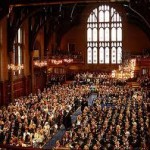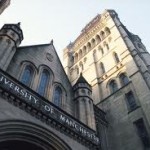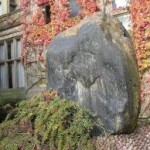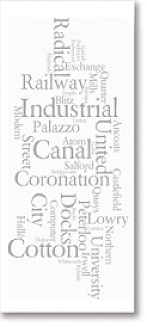Next tour: Thursday 5 July.
Start: Manchester Museum reception, off Oxford Road, Chorlton-on-Medlock, 11.30am.
Ends: The newly-reopened Gaskell House.
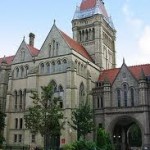 It’s the biggest centre of learning in Europe – colleges and universities, ivy-clad quads, red-brick labs, dreaming spires, and thousands of students populating a corridor of academia and accomplishment.
It’s the biggest centre of learning in Europe – colleges and universities, ivy-clad quads, red-brick labs, dreaming spires, and thousands of students populating a corridor of academia and accomplishment.
Its history is studded with Nobel Prize winners and genius achievers: Ernest Rutherford, Alan Turing, Anthony Burgess, Ludwig Wittgenstein, Chaim Weizmann…
Here are two of the greatest sites of achievement in history: the laboratory where Rutherford first explained the atom in 1911 and the room where the world’s first computer ran in 1948.
Come with us from the edge of town to explore the university quarter, ending (morning walks only) at the sumptuous Christie Library cafe in the heart of the old university buildings.
***
Extract from Ed Glinert’s Manchester Compendium on Manchester University
Manchester University, one of Britain’s most prestigious academic institutions outside Oxford and Cambridge, is the largest in the country with 35,000 full-time students and occupies the biggest single site campus in Britain.
Originally it was Owen’s College, founded on city centre Quay Street in 1851, moving to Chorlton-on-Medlock in the 1870s. New buildings fronting Oxford Road were designed by the great Gothic stylist Alfred Waterhouse, architect of Manchester Town Hall, and they are now the administrative headquarters. At the start of the next decade the college received a Royal Charter, becoming a university in 1880. In the early 20th century Manchester University scientists achieved considerable success in various fields. They included the philosopher Ludwig Wittgenstein; the chemist Chaim Weizmann, who became the first President of Israel; and Ernest Rutherford and Neils Bohr who conducted pioneering work on the nature of the atom. In 1948 a university team led by Tom Kilburn and Fred Williams was responsible for developing the first programmable computer.
Notable alumni include the comedians Ben Elton, Rick Mayall and Ade Edmonson, and the novelist Anthony Burgess, taught history by the legendary A. J. P. Taylor, who wrote on one of his essays: “Bright ideas insufficient to conceal lack of knowledge”. In Latin classes Burgess was given the task of translating into the Roman tongue the well-known lyric from a Fred Astaire musical that runs “you say ‘tomatoes’ and I say ‘tomahtoes’…” and he expertly rendered this as Dico ego ‘pomum’, dicis tu ‘phomum’.
Recent decades have seen the university maintain its high standards while devouring vast swathes of Chorlton-on-Medlock to build a giant campus – the Manchester Education Precinct – the largest of its kind in Europe. In 2003 the university merged with nearby UMIST to form an even larger institution.
Bridgford Street, south side
Birth of the Computer
Before the Second World War a computer was not the machine that aided the calculations but the person doing them – a clerk who computed – much in the same way that a typewriter used to be the person who typed. This changed in the 1940s thanks to the maths department at Manchester University.
During the Second World War a department professor, Douglas Hartree, created what he called the Differential Analyser to perform the most complex calculations. When the Germans’ magnetic mines were discovered the Analyser was the only machine that could help unravel the mechanism. Although officials from the ministry came to the university to meet Hartree and discuss its operations, for security reasons they were not allowed to see the machine itself, which was stored below the physics department building.
In 1946, with the War over, Tom Kilburn and Fred Williams from the university maths team based on Bridgeford Street built a machine out of war surplus materials that could perform calculations from a stored program, what is now recognised as the first computer, which they called Baby. They first used it on 21 June 1948, running a program written by Tom Kilburn, the world’s first and the only one he ever wrote. As Fred Williams later recalled: “The start switch was pressed, and immediately the spots on the display tube entered a mad dance. It was a moment to remember. Nothing was ever the same again.”
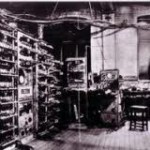 One of the computer’s first tasks, which demonstrated its scope and originality, was to find the factors of an enormous number, 218. This took it 52 minutes which compared favourably with the several hours an individual might have taken. A month later a different program was introduced by a then unknown member of the department, Alan Turing, who had been involved in the breaking of the Germans’ Enigma code and has since attained some fame owing to his unfortunate demise.
One of the computer’s first tasks, which demonstrated its scope and originality, was to find the factors of an enormous number, 218. This took it 52 minutes which compared favourably with the several hours an individual might have taken. A month later a different program was introduced by a then unknown member of the department, Alan Turing, who had been involved in the breaking of the Germans’ Enigma code and has since attained some fame owing to his unfortunate demise.
The first commercial use of a computer was taken up by a local firm, Ferranti. However America’s IBM also began making interested noises, and they invited Professor Williams on an all-expenses-paid, two-week visit to the USA in 1949 to discuss business. As Williams sat on the ship taking him across the Atlantic – the Queen Mary, no less – a phone call came from the government’s Lord Halsbury ordering him, in the nicest possible terms, not to succumb to any offers from the Americans and take up an alternative British-based offer instead. Although Williams went to IBM’s headquarters in New York, where no one could believe that a small team from “Manchester, England” (sic), had made so startling a technological breakthrough, he kept to his word and worked solely for the British. He and Kilburn went on to produce a machine that could process a million instructions in a second, but it was American, rather British companies, that forged ahead with computing science, and though the Ferranti plant in Gorton became the largest computer plant in Gorton Manchester is no longer the world’s main centre for computing science.

